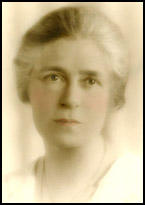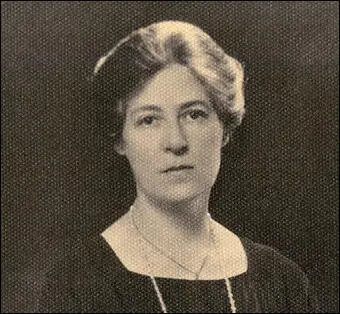Clara Codd

Clara Codd, the eldest of ten girls, was born in Bishop’s Tawton, near Barnstaple on 10th October 1876. Her father, Henry Frederick Codd, was an inspector of schools in Devon and Cornwall. On the death of her father in 1899, the family moved to Geneva.
Codd later wrote of how her experiences in Switzerland marked "the first time in life I came into contact with all sorts and conditions of men, and learned to be free and a friend of all that lives, instead of the proper, little caste-ridden Victorian that I was in the beginning." After working as a governess in Ireland, she returned home to Bath and became a member of the Social Democratic Federation. She also attended meetings of the Theosophical Society.
In 1907 she was asked by Aeta Lamb to become a steward of meeting being addressed by Christabel Pankhurst and Annie Kenney at a local Women's Social and Political Union (WSPU) meeting. The following year she became the honorary secretary of the newly founded Bath branch of the WSPU. Codd became a frequent visitor to Eagle House near Batheaston, the home of fellow WSPU member, Mary Blathwayt. Her father, Colonel Linley Blathwayt was sympathetic to the WSPU cause and he built a summer-house in the grounds of the estate that was called the "Suffragette Rest".
Members of the WSPU who endured hunger strikes went to stay at Eagle House. Mary Blathwayt recorded in her diary that Annie Kenney had intimate relationships with at least ten members of the WSPU at Batheaston. Blathwayt records in her diary that she slept with Annie in July 1908. Soon afterwards she illustrated jealousy with the comments that "Miss Browne is sleeping in Annie's room now." The diary suggests that Annie was sexually involved with Clara Codd. Blathwayt wrote on 7th September 1910 that "Miss Codd has come to stay, she is sleeping with Annie." Codd's autobiography, So Rich a Life (1951) confirms this account.
The historian, Martin Pugh, points out that "Mary writes matter-of-fact lines such as, Annie slept with someone else again last night, or There was someone else in Annie's bed this morning. But it is all done with no moral opprobrium for the act itself. In the diary Kenney appears frequently and with different women. Almost day by day Mary says she is sleeping with someone else."
Fran Abrams the author of Freedom's Cause: Lives of the Suffragettes (2003), has argued that Annie Kenney had a series of romantic attachments with other suffragettes: "The relationship (with Christabel Pankhurst) would be mirrored, though never matched in its intensity, by a number of later relationships between Annie and other suffragettes. The extent of their physical nature has never been revealed, but it is certain that in some sense these were romantic attachments. One historian who argues that Annie must have had sexual feelings for other women adds that lesbianism was barely recognised at the time."
Emily Blathwayt recorded in her diary about how Clara and Annie Kenney were attacked during a meeting in Bath. "Clara Codd was not allowed to speak but the chairman Annie said everything to the purpose as she always does and the reporters have put it all in. When the platform was about to be rushed they broke up the meeting and got some of the ladies into a smaller room where they spoke... Annie was begged to go out by the back, but she said she would not sneak out like a Cabinet Minister. The police with difficulty protected our poor man from Bence's with the fly and our four got off safely. We read Clara who walked was sadly hustled and the police got her party into the York House Mews."
On 13th October 1908 Clara Codd was arrested at a demonstration outside the House of Commons and sentenced to one month's imprisonment. Christabel Pankhurst suggested that Clara should become a full-time WSPU organiser working under Flora Drummond at a salary of £2 a week. However, she turned down the offer and after this seems to have left the WSPU.

Codd joined the Theosophical Society. In her autobiography, So Rich a Life (1951), Clara states, "I had come home at last after long wandering. I had found the beginning of the way." According to her biographer, Heloise Brown, "After a short period of employment as a teacher, she was offered work as a lecturer by the Theosophical Society, and soon spent two years at the society's headquarters in Adyar, India, as the result of a private bequest. She continued to lecture for the society throughout the 1910s, her wages being raised by the head of the movement, Annie Besant. Codd spent the remainder of her life as a travelling lecturer for the Theosophical Society, spending several years in the United States, New Zealand, Australia, where she was general secretary from 1935 to 1936."
During the Second World War she lived in South Africa. Her biographer claims that: "Codd was both unassuming and sincere; her ability to communicate directly across class and cultural barriers undoubtedly contributed to her international success as a lecturer. Her history of addressing working men and women in the socialist and suffrage movements had developed her skills as a public speaker, while her experiences as a young woman in the cosmopolitan circles of Geneva had encouraged her to be accomplished, informed, and, importantly, self-reliant."
Clara Codd, who never married, died at Heatherwood Hospital, Sunninghill, Berkshire, of heart failure on 3rd April 1971.
Primary Sources
(1) Emily Blathwayt, diary entry (18th November, 1908)
The London papers have account of the row, and the Bath papers are horrified, especially the liberal Herald. About 200 hooligans made a rush from the back after the hall, being full, was supposed to be closed... Mary said it was "a grand advertisement" for them. Clara Codd was not allowed to speak but the chairman Annie said everything to the purpose as she always does and the reporters have put it all in. When the platform was about to be rushed they broke up the meeting and got some of the ladies into a smaller room where they spoke... Annie was begged to go out by the back, but she said she would not sneak out like a Cabinet Minister. The police with difficulty protected our poor man from Bence's with the fly and our four got off safely. We read Clara who walked was sadly hustled and the police got her party into the York House Mews.
(2) Emily Blathwayt, diary entry (23rd April, 1909)
Beautiful day for the tree planting and Linley photographed the three in a group at each tree. Annie put the West one, Mrs. P. Lawrence, South, and Lady Constance the East. Miss Codd came to the field. Then Linley took others indoors and they left in his motor.
(3) Emily Blathwayt, diary entry (24th April, 1909)
Affectionate letter from Mrs. Lawrence. Clara Codd came over and she and Miss Canning each planted a tree. Rawlings (the handyman) was there by his own choice and quite entered into the idea.
(4) Vanessa Thorpe and Alec Marsh, The Observer (11th June 2000)
Entries in the diary of a suffragette have revealed that key members of the Votes For Women movement led a promiscuous lesbian lifestyle.
The diaries of supporter Mary Blathwayt, kept from 1908 to 1913, show how complicated sexual liaisons - involving the Pankhurst family and others at the core of the militant organisation - created rivalries that threatened discord.
"Mary, who had been something of a favourite, often wrote quite bluntly about the situation. It does sound as if she was occasionally quite jealous," said Professor Martin Pugh, an expert on the history of the movement, who came across the relevant and explicit pages in Blathwayt's little-known diary.
"This part of the diary puts the whole campaign in a truer perspective," he added. "All these women were under an enormous amount of pressure from around 1912, while the Home Secretary was trying to suppress their activities."
Pugh, of Liverpool John Moores University, said the tensions felt, both physically and psychologically, meant the activists had to find sus taining relationships within their own ranks.
Emmeline Pankhurst and her three daughters, Sylvia, Christabel and Adela, were the leading figures in the battle to win votes for women. Founding the hardline Women's Social and Political Union in 1903, Mrs Pankhurst, as she was popularly known, went to prison 15 times for her political views and had a close relationship with the lesbian composer Ethel Smyth for many years following the death of her husband Richard in 1898.
"Dame Ethel had realised early on in life that she loved women not men and was fairly bold about things. They were often in Holloway together and shared a cell," said Pugh.
Members of the union were social pariahs and the butt of music-hall jokes, but they were also criminals. Under the slogan Votes for Women and Chastity for Men, they bombed and set fire to churches and stations, threw bricks through windows, cut telegraph wires and tied themselves to railings.
"This was a period in which these women were carrying out something like guerrilla war - they felt they were engaging in battle with the Home Secretary, who was using all the tools of the state to oppress them," said Pugh, who is researching a biography of the Pankhurst family.
Christabel was the most classically beautiful of the Pankhurst daughters and was the focus of a rash of "crushes" across the movement. Pugh now believes she was briefly involved with Mary Blathwayt who, in her turn, was probably supplanted by Annie Kenney, a working-class activist from Oldham.
"Christabel was an object of desire for several suffragettes," he said. "She was a very striking woman."
Many of the short-lived sexual couplings referred to in the diary took place in the Blathwayt family's Eagle House home in Batheaston, near Bath.
Kenney's frequent visits to Eagle House, and to the family's Bristol lodgings, receive most scrutiny from Mary Blathwayt. Pugh's research shows that her name can now be linked to up to 10 other suffragettes.
"Mary writes matter-of-fact lines such as, "Annie slept with someone else again last night," or "There was someone else in Annie's bed this morning," said Pugh. "But it is all done with no moral opprobrium for the act itself. In the diary Kenney appears frequently and with different women. Almost day by day Mary says she is sleeping with someone else."
Kenney, organiser for the South West, volunteered to join the suffragettes after hearing Christabel Pankhurst speak at a rally in 1905. The two were sent to prison together that year after disrupting a public meeting and had an intimate friendship for several years until Christabel became involved with another woman, Grace Roe.
While the affairs and one-night-stands at Eagle House provoked competitive rivalries, it is also clear they held the movement together. Many of the relationships provided emotional support for members of a group isolated from the rest of society.
"Biographers, while acknowledging a small lesbian element in the movement, have all skirted around the issue," said Pugh. "For those times the matter-of-fact tone Blathwayt adopts about the affairs did surprise me."
The union suspended its militant activities to help the war effort in 1914 and women over 30 gained the vote in 1918. Equal suffrage was finally achieved in 1930.

